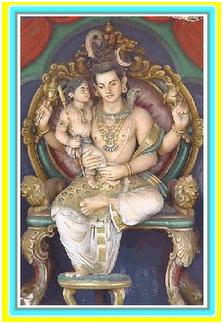Swamimalai Sri Swaminathar
Swamimalai is located 7 kilometers from Kumbakonam. Swamimalai is one of the Aru Padai Veedu Temples for Lord Muruga (Sri Swaminathaswamy), who is the main deity here. Nakkeerar in his Thirumurugaatruppadai and Arunagirinathar in his Thiruppugazh have written hymns in praise of Lord Muruga here. This temple is associated with the legend of Lord Muruga re-initiating his father Shiva by teaching him the Pranava Manthra - Omkara and its meaning.
Temple Creation[edit]
This temple is built on an artificially-made small hill, reached through a plight of 60 steps denoting 60 Tamil years. Facing the sanctum is an elephant instead of a peacock, which is unusual in Lord Muruga temples. Sri Meenakshi Sundareswarar Temple at the foot hill is said to have been built by the Pandya ruler Varaguna Pandyan from Madurai. The golden chariot is taken in procession on special occasions here. The stala vriksham is the Nellimaram and this tree is said to be a manifestation of Bhudevi.
Lord Shiva & Naming[edit]
According to mythology, Saint Bhrugu, before commencing a penance, received the boon that whoever disturbs his meditation will lose all his knowledge and wisdom. Due to the power of his penance, a sacred fire emanated from his head and reached up to the heavens, which frightened the Devas. They surrendered to Lord Shiva praying to save them. The Lord extinguished the sacred fire by covering the saint's head by hand.
As Lord Shiva disturbed the penance, he lost all his knowledge or Gnana and is said to have regained them by learning the Pranava mantra from Lord Muruga at this shrine. Once when Brahma, the creator, was proceeding to Kailasa, the playful child Lord Muruga asked him for the meaning of the Pranava Manthra "OM". When Brahma admitted that he did not know it, Muruga imprisoned him. As a result, all creations came to a standstill and the Devas prayed to Lord Shiva to get Brahma released. Lord Muruga insisted that the imprisonment was a right punishment for the ignorance of Brahma. Lord Shiva asked Muruga whether he himself knew the meaning of Pranava Manthra.
Lord Muruga said that he knew the meaning of OM and could teach the same to Lord Shiva, provided if the latter can accept him as his Guru and listen to him with full devotion and Bhakthi. Lord Shiva agreed and listened to him obediently as a disciple whilst Lord Muruga taught him the meaning of the Pranava Manthra. As Lord Muruga became a Guru to the Swami (Lord Shiva) himself, the place came to be known as Swamimalai and the presiding deity as Swaminathan.
Temple Address[edit]
Arulmigu Swaminatha Swami Temple, Swamimalai - 612 302. Thanjavur district. Tamil Nadu.


